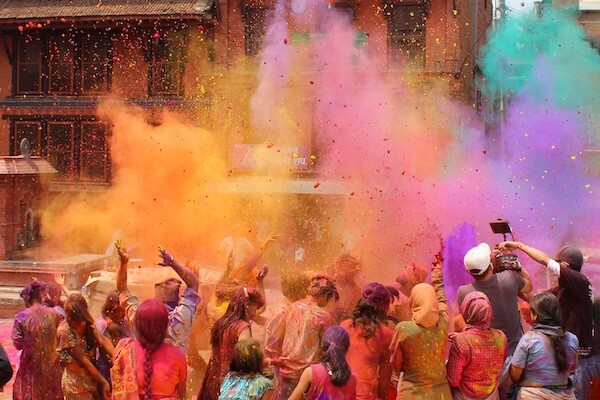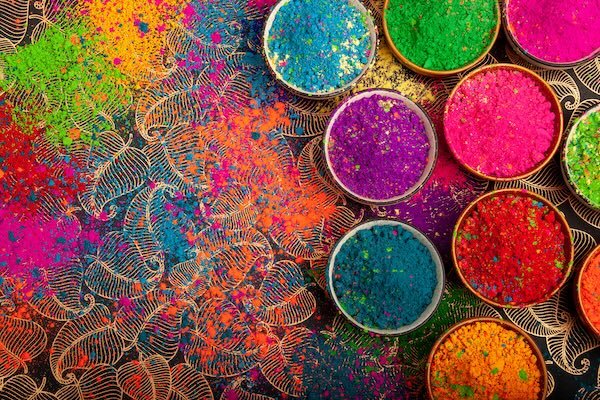Holi, also known as the Festival of Colors, is an exuberant Hindu holiday celebrated all over the world. This joyful celebration is rooted in India but has become an expression of love and unity for those with Indian heritage in many countries. The purpose of Holi is to refresh the spirit and honor cultural traditions.
When and Why Is Holi Celebrated?
Traditionally a Hindu holiday, Holi is celebrated in India, Nepal, other South Asian countries, and increasingly around the world, even by those not of Indian descent. This revered festival falls on Purnima (the full moon) of Phalguna (the last month of the Hindu lunar calendar). On the Georgian calendar, Phalguna usually occurs some time during the months of February or March. In 2025, Holi is on 14 March.
A 2-day celebration, Holi has both religious and cultural meaning. It marks the arrival of spring and, with it, a sense of renewal. This renewal of nature extends to a renewal of relationships. Holi is a time to forgive past trespasses and start anew!

Holi is also a time to bring people of a community together regardless of economic or religious differences. Holi activities may vary slightly from place to place, but the main themes are the same: unity and love. Activities include music, dancing, food, and most famously the throwing of colored powders called gulal and colored water.
Bonfires at night symbolize the burning away of evil. Throwing colored powders and water the next day symbolizes breaking down barriers between people and showing reverence for nature and tradition.
Each color, all originally from flowers and herbs, has its own connotation: red for love, yellow for health, sunshine, and happiness; blue for the Hindu god Krishna and for protection; and green for rebirth and fertility. The act of throwing is a light-hearted and joyful sharing of values and beauty.
What Is the Story Behind Holi?
Holi has deep roots in Hindu mythology. More than one story is used to explain the origins and significance of the festival.
Prahlad and Holika
One of the more popular stories is the story of Prahlad and Holika. The myth begins with an evil ruler, King Hiranyakashipu, who wanted to live forever. He forced all his kingdom to worship him as a god. His son Prahlad was a devoted follower of the Hindu god Vishnu and refused to worship his father.

Furious, the king enlisted the help of his sister, Holika, to murder his son. Holika was said to be immune to fire. She was to take Prahlad into the fire with her so he would be burned, but she would live.
According to the myth, Vishnu protected Prahlad from the flames, but Holika was consumed. This version of the origin of Holi symbolizes the victory of good over evil and represents the tradition of lighting a bonfire the night before Holi.
The lighting of bonfires on the eve of Holi is also known as Holika Dahan. Holika is the name of the demon woman who tried to remove Prahlad and Dahan means set on fire.
Krishna and Radha

Another popular myth about Holi is of Krishna and Radha. Together, these two were believed to be a supreme being and eternally in love. On the day of Holi, Radha decided she did not want to go to her local festival because she wanted to spend the day with Krishna at his hometown celebration.
To avoid disappointing Radha’s family and townsfolk, friends of both Krishna and Radha worked together to help the lovers meet in a grove at Vrindavan and still make it back in time to celebrate with their respective families. This romantic story gives Holi yet another name—the “Festival of Love.” Love prompts the creative power of working together to solve problems.
Another part of the couple’s story reveals the origin of throwing colored powders! Krishna had a dark complexion and was jealous of Radha's fair skin. When he told his mother this, she suggested he cover Radha with beautiful colors. Playful Krishna did so, which explains the tradition today of throwing bright, colorful powders and water on Holi.
Lathmar Holi is still another tradition springing from the legend of Krishna and Radha. Practiced in some towns in India, Lathmar Holi is a pretend “beating of the sticks.” In the legend, the mischievous Krishna drenched girls with colored water and powder, and they retaliated by hitting him with sticks. Re-enactments of this legend take the form of a light-hearted dance or charade, in which the men walk toward the women, and the women act out beating the men with sticks or “lathis.”
What Is the Difference Between Holi and Diwali?
Holi is a “Festival of Colors” and Diwali is a “Festival of Lights.” Both holidays are Hindu celebrations, but they are significantly different. Holi is an exuberant, fun-filled celebration that happens in the spring and lasts 2 days. Diwali is a more subdued, family-focused holiday celebrating light over darkness. It happens in the fall, usually in late October or November and lasts 5 days.
Diwali observances include lighting candles and little clay lanterns called diyas. Decorating houses and businesses with lights of all kinds adds to the beauty of Dwali. Nighttime fireworks also add to the light and excitement of Diwali.


Diwali is sometimes compared to the Christian holiday of Christmas. Both include lights, gift-giving, and family time. Different regions of India have different origin stories of Diwali, but most include worshiping Lakshmi, the Hindu goddess of wealth, who was believed to be born on Diwali.
In northern India, people celebrate Diwali as the day Lord Rama returned from 14 years in exile. The lights lead Rama home. Some parts of southern India celebrate Diwali as the day Krishna defeated the demon Narakasura.
How Else Do People Celebrate Holi?

Food, food, food! No celebration would be complete without food traditions. Holi is no exception. Gathering with friends and family to enjoy food is an important part of the holiday. Holi foods are sweet, savory, fried, or baked--and everything in between!
One particularly popular treat is gujiya, a sweet, flaky pastry filled with khoya (a condensed milk solid) and nuts. This crescent-shaped delight can be fried or baked. Dhuska is also often served. Dhuska is made with dal, rice, garlic, and chilies and sometimes served with ghungni (similar to a pea soup). Ragda chaat, also called matar chaat, is a favorite savory snack made with dried white peas and topped with onions, tomatoes, chutney, and spices.
When you are done eating all that delicious food on Holi, enjoy a glass of thandai. This drink helps to cleanse the palate. Thandai is usually made of a milk base, combined with nuts, seeds, dried fruit, and saffron.

Your Indian Heritage
Do you or your ancestors have Indian or Hindu heritage? If you aren’t sure, you can tap into the "Where Am I From?” experience at FamilySearch.org. This fun discovery activity will show you whether you have ancestors from India and other countries who may have celebrated Holi.
In the comments below, share with us your favorite Holi traditions or what you plan to do this year to celebrate!
Related Articles
At FamilySearch, we care about connecting you with your family, and we provide fun discovery experiences and family history services for free. Why? Because we cherish families and believe that connecting generations can improve our lives now and forever. We are a nonprofit organization sponsored by The Church of Jesus Christ of Latter-day Saints. To learn more about our beliefs, click here.






